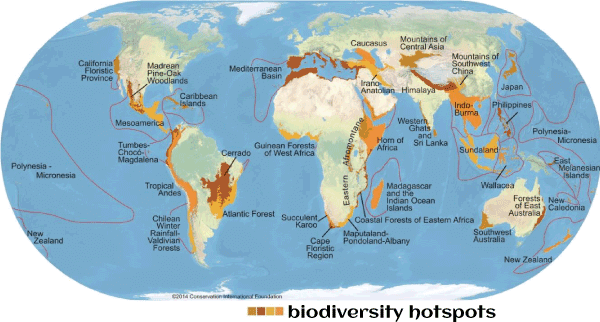Biodiversity HotspotsThere are areas on the planet that are both biologically diverse and critically endangered. We must try to defend them for our own sake. Species are the building blocks of Earth's life-support systems. We are all reliant on them. However, our world's "biodiversity," or the great variety of species on the earth, is facing a catastrophic crisis. All of these factors are playing havoc on the tree of life: development, urbanization, pollution, and disease. Species are disappearing at a quicker frequency than they have subsequently the dinosaur extinction. 
To avert this disaster, we must safeguard the habitats of biodiversity. However, species are not equally dispersed around the globe. A considerable number of endemic species - those found nowhere else - can be found in some places. Habitat destruction and other human activities have put many of these species in jeopardy. These are the biodiversity hotspots, 36 places where successful species conservation can have a huge impact on preserving global biodiversity. Only 2.5 percent of the Earth's land surface is covered by forests and other remaining habitats in hotspots. Nonetheless, finding another 2.5 percent of the world that is more vital would be tough. There are 36 hotspots located around the globe. Their complete ecosystems comprise only 2.5 percent of the Earth's land surface, yet they are home to over half of the world's plant species, as well as nearly 43 percent of bird, mammal, reptile, and amphibian species. What is a biodiversity hotspot?To be designated as a biodiversity hotspot, a terrain must have lost at least seventy percent of its unique natural vegetation, which is principally due to human activity. Around the world, more than 30 biodiversity hotspots have been identified. Why are biodiversity hotspots so important?Conservation International was one of the first organization's to define and promote the notion of hotspots. In 1989, Conservation International made the goal of protecting these beautiful places the driving principle of our work, just one year after scientist Norman Myers published the study that popularized the concept of hotspots. Hotspots were the blueprint for its work for about two decades after that. Its purpose has grown to include more than just protecting hotspots. We know that protecting species and locations is insufficient; in order for mankind to exist and prosper, environmental preservation must be an integral element of every human community. Biodiversity is the bedrock of all life on the planet. If species did not exist, there would be no oxygen to breathe, no food to eat, and no water to drink. There would be no such thing as a human society if this were the case. Hotspots are crucial to human life because they are the regions on Earth where the most biodiversity is threatened. The pattern of hotspots is extremely well aligned with the map of natural areas that are most beneficial to people. Because hotspots are home to many vulnerable populations that are completely reliant on nature for survival, they are among the world's richest and most essential ecosystems. Forests, wetlands, and other ecosystems in hotspots are considered to provide 35 percent of the "ecosystem services" that vulnerable human populations rely on, although covering only 2.5 percent of the Earth's land surface, according to one estimate. Around the world, more than 30 biodiversity hotspots have been identified. The Andes Mountains' Tropical Hotspot is the world's most diverse hotspot. This region is home to almost one-sixth of all plant species on the planet. Another hotspot is the New Zealand archipelago. Because New Zealand's life evolved in isolation, the islands are home to several species that aren't found anyplace else. In New Zealand, more than 90% of the insects and 80% of the vascular plants are indigenous to the area. The Himalaya area is a habitat to the planet's tallest mountains, along with unique fauna including the giant panda, wild water buffalo, and the world's only alpine crane, the black-necked crane. The Himalayas has become a biodiversity hotspot due to deforestation and climate change.
Next TopicLevels of Biodiversity
|
 For Videos Join Our Youtube Channel: Join Now
For Videos Join Our Youtube Channel: Join Now
Feedback
- Send your Feedback to [email protected]
Help Others, Please Share









